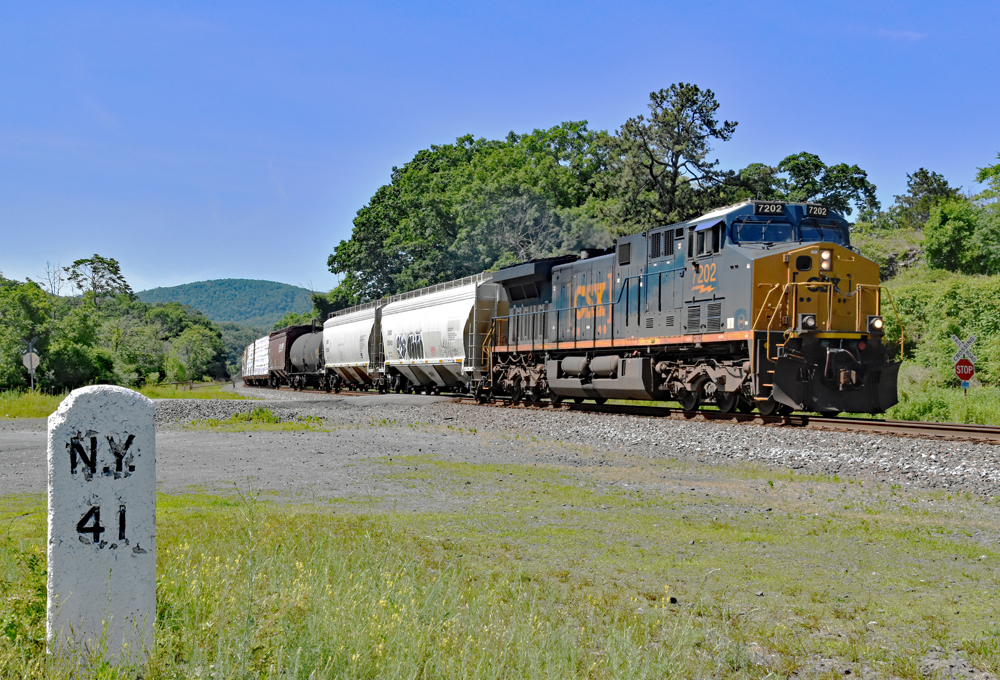
JACKSONVILLE, Fla. — CSX Transportation is awaiting regulatory approval to become the first railroad to use Trip Optimizer’s Zero-to-Zero function, which allows the advanced cruise control system to automatically start and stop freight trains.
The goal, CSX says, is to save fuel as part of the railroad’s effort to reduce its greenhouse gas emissions by 37% by 2030. “Zero-to-Zero is a big piece of that … to improve fuel economy on line-of-road. We’re doing everything we can to reach those goals,” says Corey Davis, CSX’s director of fuel strategy and utilization, who headed the railroad’s Zero-to-Zero test program.
In conventional Trip Optimizer use, the system’s auto throttle mode works at speeds of 12 mph and above. Wabtec says Trip Optimizer can apply dynamic brakes, and when air brakes are required can recommend how much air the engineer should use and for how long, as well as when to release brakes. CSX trains have rolled off more than 23 million miles under auto control so far this year, Davis says.
Zero-to-Zero goes a step further than automatic throttle and dynamic braking. It gives Trip Optimizer control of the train’s air brakes, which allows it to start and stop a train automatically. The system receives signal aspects and track authorities from the positive train control system.
What Zero-to-Zero can’t do: Operate a train automatically in areas where there are no signals, such as yards, or when entering passing sidings that require a train to stop within half the engineer’s range of vision.
But it can automatically stop and start trains on the main — for crew changes, for example — as well as depart from passing sidings.
A couple of years ago CSX analyzed its Trip Optimizer operations and asked how it could get more benefits out of the energy management system that reduces fuel use. The first place to look was areas where Trip Optimizer wasn’t available, such as slow speeds and stopping and starting.
The biggest opportunity was taking advantage of places where Trip Optimizer would give control back to the engineer in advance of a red signal, Davis says. So CSX saw Zero-to-Zero as the solution. “It’s the best way to save fuel for all of those mainline miles,” Davis says.
CSX estimates Zero-to-Zero will save about 5 million gallons of diesel fuel annually. That translates into a roughly 1.3% reduction in diesel fuel use, based on the 362.1 million gallons that CSX locomotives burned in 2021. At this year’s average fuel price, Zero-to-Zero also would save CSX nearly $18.5 million.
Zero-to-Zero also brings safety benefits by reducing the risk of train pull-aparts when starting, stopping, or upon application or release of air brakes, Davis says.
“We were really impressed with how well it can actually operate the train and prevent train separations,” he says. “We never had an issue on any of our test runs, never had any separations while Trip Optimizer was running. So we see a significant benefit and improvement in safety in not having those train separations.”
CSX began testing Zero-to-Zero in December 2020, then continued throughout 2021 on several of its main lines.
Among the locations: Between Hamlet and Wilmington, N.C.; between Birmingham and Mobile, Ala.; and between Pensacola, Fla., and Nashville.
“We did hundreds and hundreds of train starts,” Davis says, including trains with conventional locomotive consists on the head end and other trains with distributed power.
The tests began on the flat territory between Hamlet and Wilmington before moving on to the hill-and-dale main linking Birmingham and Mobile.
The route includes some of the most challenging undulating territory on the CSX system, Davis says. “You make many running airbrake applications on that railroad,” explains Davis, a locomotive engineer who at one time was CSX’s system road foreman of engines.
Zero-to-Zero was able to successfully operate 200-car coal trains over the route.
The test trains included a passenger car behind the locomotives so that personnel from CSX, Wabtec, and the Federal Railroad Administration could monitor their progress.
At the end of 2021 FRA shifted its evaluation of Zero-to-Zero to a different rule, which required CSX to shift testing to the MxV Rail Transportation Technology Center in Pueblo, Colo. Those tests wrapped up this year.
Davis rode every mile. How did engineers react to full automation?
“It’s been mixed,” Davis says. “For the most part, it’s been positive.”
Many engineers were apprehensive at first. “I’m a locomotive engineer, so I can relate,” Davis says. By the end of their Zero-to-Zero trips, though, the engineers were accepting of the technology and some even said the railroad has always needed it, Davis says.
FRA is currently reviewing the safety plan and test results that CSX submitted to the agency. “They’ve been involved and are generally supportive of what we’re trying to do,” Davis says.
Two federal safety regulations — one governing locomotive safety standards and another regarding any safety-critical changes to a positive train control system — cover CSX’s Zero-to-Zero testing.
As a result, a cross analysis must be conducted to ensure that Zero-to-Zero doesn’t introduce hazards to either train control or PTC, says FRA spokesman Cory Gattie.
“Once the analysis work is completed further testing can be allowed,” Gattie says.
CSX wants to test Zero-to-Zero on steep grades such as Sand Patch in Pennsylvania and Cowan Mountain in Tennessee, where manned helpers complicate operations.
While other railroads have talked about using Zero-to-Zero to automate operations — which is not the same as autonomous operations — CSX says its focus is only on fuel savings.
Meanwhile, the Class I railroads are closely watching CSX.
Once FRA approves Zero-to-Zero based on CSX’s test, the other Class I systems are expected to follow CSX’s lead. As with positive train control implementation, there’s no need for each railroad to reinvent the wheel as part of their application process with the FRA.
“We’re all waiting for the FRA,” says Jamie Helmer, Norfolk Southern’s director of fuel efficiency. “Our paperwork’s with the FRA as well.”
Zero-to-Zero is a natural progression for Trip Optimizer’s energy management functions, Helmer says.
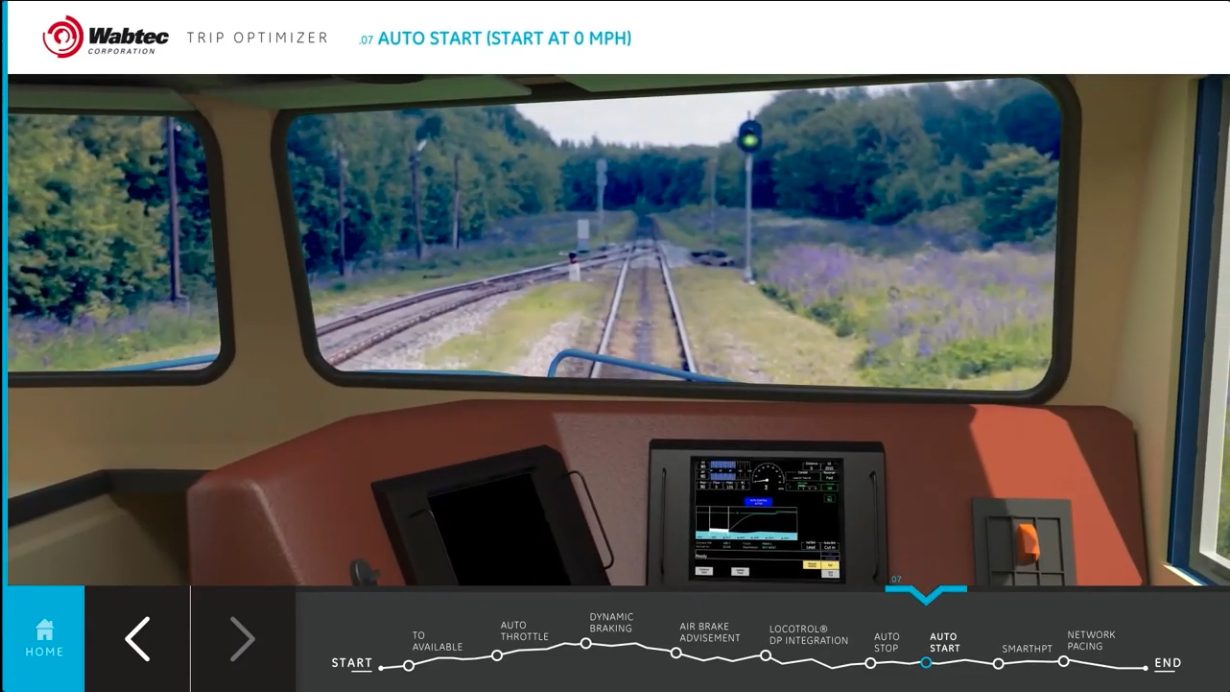
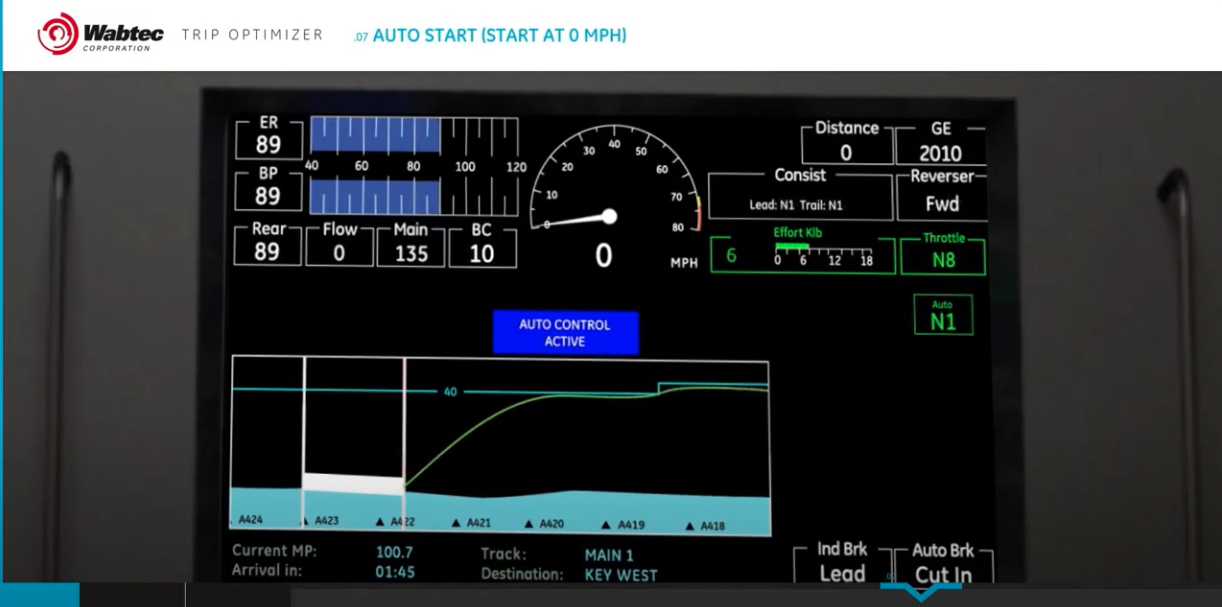







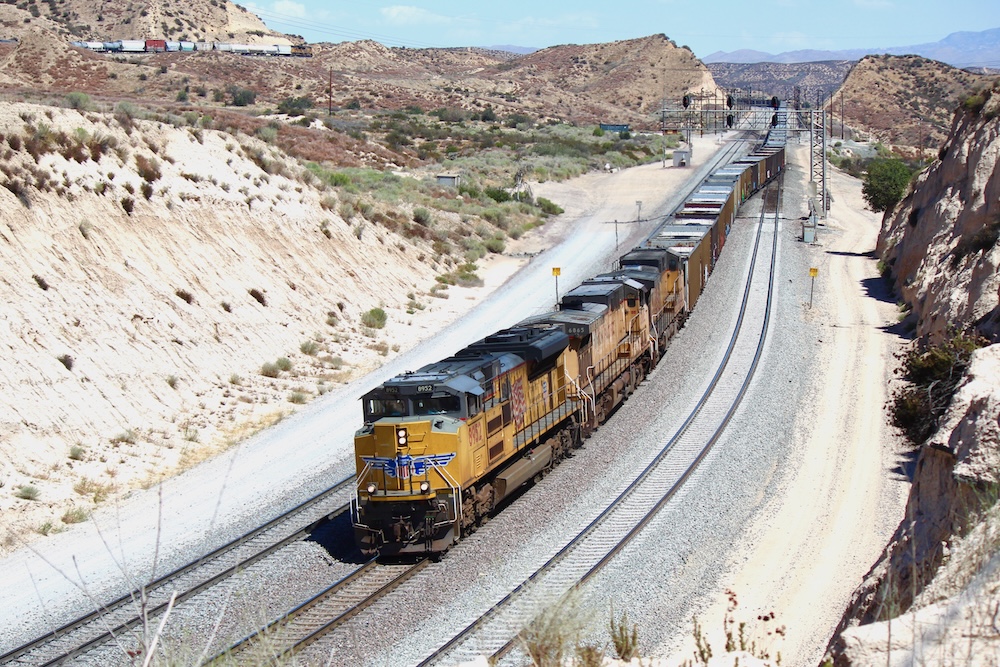
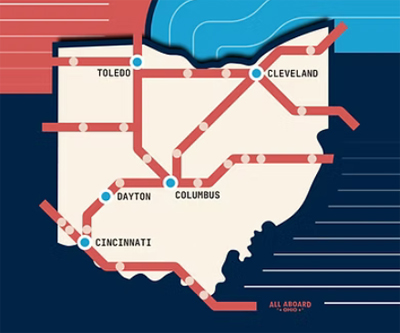
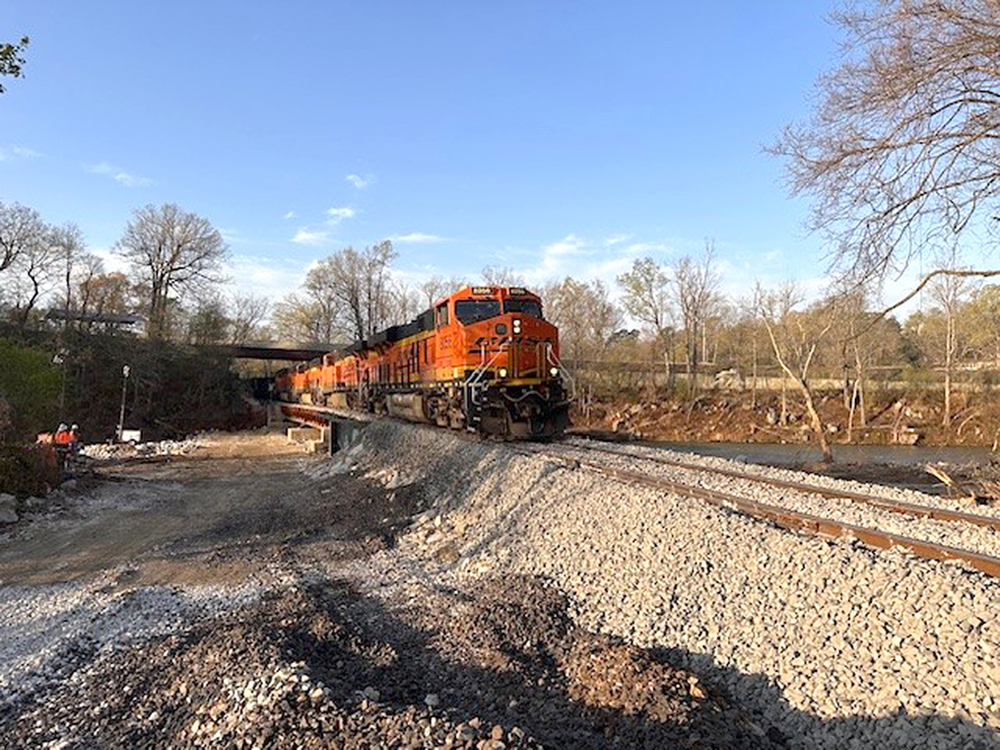




Reading the article above it seems as if the railroads who are implementing the trip optimizer are trying to save fuel. I would have to disagree.
In a few months i will have 30 years as an engineer for the BNSF railway. I do not see the zero to zero optimizer as a fuel saving device. The reason I say this is that if the trip optimizer is operating as intended I have noticed that that it runs the train at a higher throttle that I am capable of using on my own. The crews are restricted for example to throttle notch 6, as well as a further restriction of having to be idle at speeds above 40 mph. While the computer (trip optimizer) when operating the train runs in throttle notch 8 and does not have the further restriction of idle above 40 mph.
The trip optimizer pulls trains in throttle eight well above 40 mph, so where are the fuel savings?
So if this was simply about saving fuel the computer would be restricted to the same throttle and speed restrictions as its human counterparts are.
To me this is simply about replacing existing human crews with a combination of remote and automated control.
Railroads are not concerned about saving fuel, or servicing its customers but rather eliminating crews.
My question to railroads is will they pass on the savings from eliminating crews to their customers once they are successful in ridding crews from their cabs?
Couple of engineers have hi-lighted the lack of speed and rightfully so. You rarely see freights running track speed. If railroads were really interested in speed they would make a change to the automated program to run track speed like they used to do. Railroads will spend all kinds of money on technology and never look back but, they will not do the same for employees who can and could run track speed. That “run speed” is the basic reason the railroads have plugged main lines etc. You can bet your boots that as long as O R is the guide it will not change.
The last sentence tells us what TO is meant to do: not burn fuel. The first goal should be to move freight expeditiously and safely for the benefit of the customer. What is the comparative fuel savings using TO? I want to see the data. PSR, modern diesels, and double length slower trains have already squeezed out a lot of efficiency. How much is left? I can drive really slow to save fuel, but also create a host of other problems. Is TO doing the same? Meanwhile, the big rigs pass me on I-20 doing 80. Seems we are getting this backwards. Show me the data!
Next stop Autonomous trains…engineers need not apply!
One more thing: that bottom picture of Trip Optimization, I’ve NEVER seen that EVER even on super fast Z trains. You rarely see TO run anywhere close to track speed and you’ll never see a line going so quickly vertical like that. NEVER. I’ve NEVER seen my train TO have a profile like that getting up to speed in under 2 miles, than going from 40 MPH to 50 MPH that quickly either. I’d bet very few, if any engineer’s have seen a TO profile that looked anything like that. That photo is simply “computer animated propaganda”, nothing more. If TO actually ran like that, most of us wouldn’t absolutely DESPISE the technology, and try not to use it. I’m so happy these days when I get an EMD vs a GE with this garbage.
I’m telling you, as an engineer out here running, the days of being paid “trip rates” need to end. Pay us hourly rate with overtime after 8 hours, because the Railroads DO NOT WANT TO MOVE FREIGHT for their customers. They want to increase their record profits at the expense of their employees and customers. All this is going to do is significantly SLOW DOWN every train. As it is now, TO runs prohibitively slow. You virtually NEVER run track speed anymore unless your a high priority intermodal train. Trip rates were an incentive to move freight. TO does just the opposite. Now you add the additional “starting and stopping” to it, and it’s going to be maddening taking forever to move freight. Pay me an hourly rate and I’ll be happy to run your severely UNDERPOWERED .002 HPT, 15,000 Foot, trains at 10 MPH everywhere. No problem. What these railroads are looking to do is make every run 12 hours long from point A to point B, even if it’s a lousy 98 miles, and run their trains at 8 – 10 MPH all to save fuel. I truly hope Congress steps in and brings back significant regulations. It’s the only way to slow these “bullies”, ala Class 1 CEO’s, down. They have no issues abusing their workforce and blocking American towns each day all so they can increase record profits to their shareholders. They do NOT care about their customers one iota, just their cash.
Just remember: Automation is a great benefit…Until it isn’t…..
It would seem that the automated ‘Holy Grail’ is to eliminate another body, and its wages out of the cab. Safety…. Really?
Now if we could only have Executive Optimizer. Turn them on and off as needed. Squeeze knowledge out of them for the least amount of salary. Furlough them when business is slow. Work them all hours of the day with no personal time off. You could save millions.
Great comment!! LMAO!!!
While you jest, this is absolutely coming.
PATCO started getting their transit operators to run trains manually at least once a day on their otherwise automated system, so that they would have the practice to not overrun stations on manual operations.
PATCO (Phila-Lindenwold NJ High Speed Line) started with manual control in 1969. When they got Automatic Train Operation up and running a year later, they required the operator to control the train manually one trip a day.
Operators usually control the trains in inclement weather. Evidently the Mark I eyeball and its attached brain work better than any automatic system.
Mr. Wheeler is correct regarding developing excessive reliance on automation.
We have been down this road in aviation and the outcome can be quite bad, either when the automation kills you because you can’t figure out what it is doing and/or disable it (Lion Air 610, Ethiopian 302), when it disengages unexpectedly and the pilot doesn’t know how to fly without it (Air France 447), or when the pilots don’t understand how it works (Asiana 214).
For good videos search for “Children of the Magenta”, a reference to the magenta line on displays that pilots can use for guidance.
FYI, airlines require their pilots to make a certain percentage of hands-on landings so the won’t degrade their proficiency by relying too much on auto-land systems.
Technology is a wonderful thing until it breaks. As usual, the author gushes about all the wonderful things ZTZ can do, without mentioning the possible downsides. As the airlines have found, taking the pilot out of the flying loop and leaving it all to the computers can create unexpected problems. It just seems to me that as new hires learn to become dependent on ZTZ they won’t be able to respond quickly or efficiently when the system goes down.
Haven’t I read that Trip Optimizer results in slower train speeds, which creates congestion and more re-crews out on the road? This, of course, leads to more customer dissatisfaction and loss of business, and more potential regulation from the STB because service is already poor. So how much of that claimed $18.5 million would it actually save?